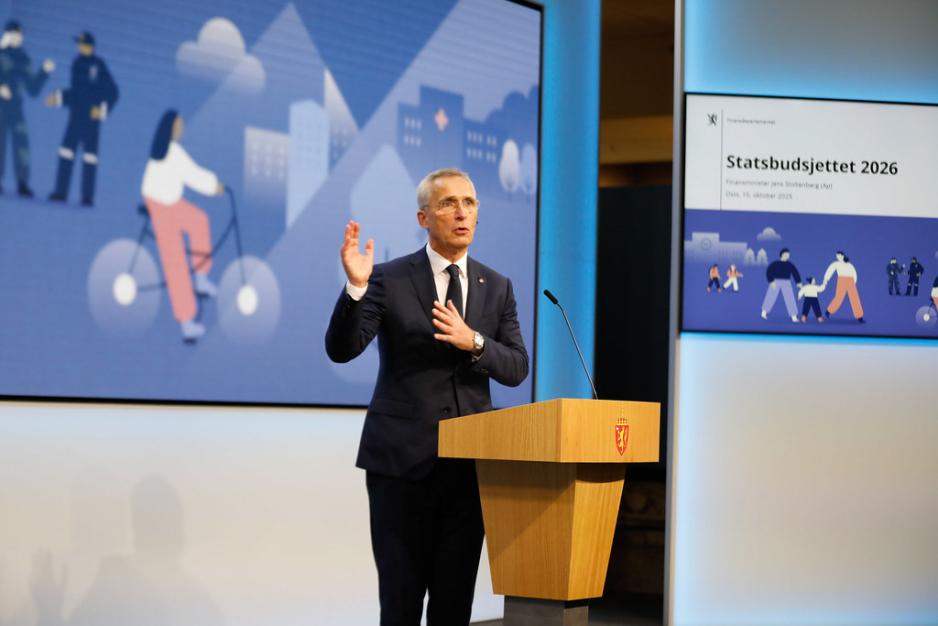Arne O. Holm says The Norwegian State Budget: Almost Every Coin Spent in the North is Due to Russia

Finansminister Jens Stoltenberg legger fram forslag til statsbudsjett for 2016. (Foto: Ida Laingen / Finansdepartementet)
Comment: Those who are still unsure of what governs the High North policy should take a look at the Norwegian state budget for 2026. Three ministries clearly state that this is about defense and security policy. To whatever degree the North is strengthened, it is purely due to the threat from Russia.
This is a comment written by a member of the editorial staff. The comment expresses the writer's opinions.
One must discuss whether the measures are too late, and when they arrive, if they achieve what they need to.
Well, discuss. So far in the press coverage, the Northern Norwegian media are quite alone in referring to the government's High North policy. The national significance of the High North is overshadowed by taxes on alcohol and snus.
The annual headlines saying "this is what the state budget entails for you" are merely suitable to fool us into thinking the fate of the nation relies on diesel taxes.
The safety of the nation
More meaningful analyses of the budget are for the particularly interested, and the High North policy is and will remain a topic exclusively for us who live in the North, while it is, to the greatest extent, about the nation's security.
When I do a deep dive into the budget, a state budget that left the newspaper's front pages as soon as a Dancing with the Stars contestant withdrew from the show, the statements regarding the so-called investment in the North show that this is all about defense and nothing but defense.
Dancing with the Stars took precedence over the state budget.
"In the face of the current challenges and geopolitical situation, it has never been more important that we have a sustainable, strong, and resilient North," said Minister of Foreign Affairs Espen Barth Eide in a press release on the Ministry of Foreign Affairs, the Ministry of Defense, and the Ministry of Local Government and Regional Development's websites.
According to the Minister of Local Government and Regional Development, Bjørnar Skjæran, the High North policy will also "strengthen our national security and preparedness ability," and is, to quote the Minister of Defense, Tore O. Sandvik, "crucial to the defense of Norway and NATO."
In the context of a budget, everything in and about the North is about deterrence and defense. Or preparation for a possible war, to be a smidge more dramatic.
However, the political reception of the state budget is about completely different things.
Symptomatically in this respect, the Center Party, which until recently was in government with the Labor Party, refuses to negotiate, partly because diesel prices are increasing and some passport offices are being replaced with buses.
The faith of the nation is not decided by diesel taxes.
Meaningless
To the Center Party's defense, they have never been particularly concerned with the High North. Instead, they talk about regional Norway as if it makes sense to compare towns in the south with municipalities in the North.
With a few very special exceptions, the state budget for the High North is largely a concretization of the government's High North strategy as it was presented at the end of August.
The budget reinforces measures in the action zone, i.e., Finnmark and parts of Northern Troms. Yet, the greatest effect, according to the budget, will come in the shape of a dramatic increase in defense spending, both direct and indirect.
Among other things, it concerns the Armed Forces' need for better infrastructure, such as roads and buildings.
The more experimental attempts to lure people northward through increased child benefits, student loan write-offs, and free kindergarten have not resulted in reduced emigration so far.
Whether a reinforcement of those same measures will work remains to be seen.
In retrospect, it is easy to see that many of the measures came too late. It is difficult to stop a moving train.
Therefore, the question is whether the whole of Northern Norway should be included in some kind of action zone, before it is too late, given the geopolitical backdrop. Because even the largest cities are struggling.
Civil society
The military effort is dependent on the civil society around it, and both the relative and actual population are decreasing in the north.
The whole of Northern Norway as an action zone.
The healthcare sector is struggling, and seen from the outside, it seems like Northern Norwegian municipalities are competing to get on the Robek list, a list of municipalities in economic unbalance under state control, not to avoid it.
While it has previously been small municipalities that were at risk of getting put under state control, big cities such as Tromsø, Alta, Rana, and Bodø are now struggling to stay afloat.
That is largely self-inflicted, but no less serious for both the cities and the nation.
I am watching the presentation of the state budget from the Icelandic capital, Reykjavik. In the next few days, a couple of thousand people will gather who are more concerned about the High North than the vast majority.
So if things are going badly for the High North, the Arctic conference market is still in full swing.
I am not at all sure if that is any consolation.



